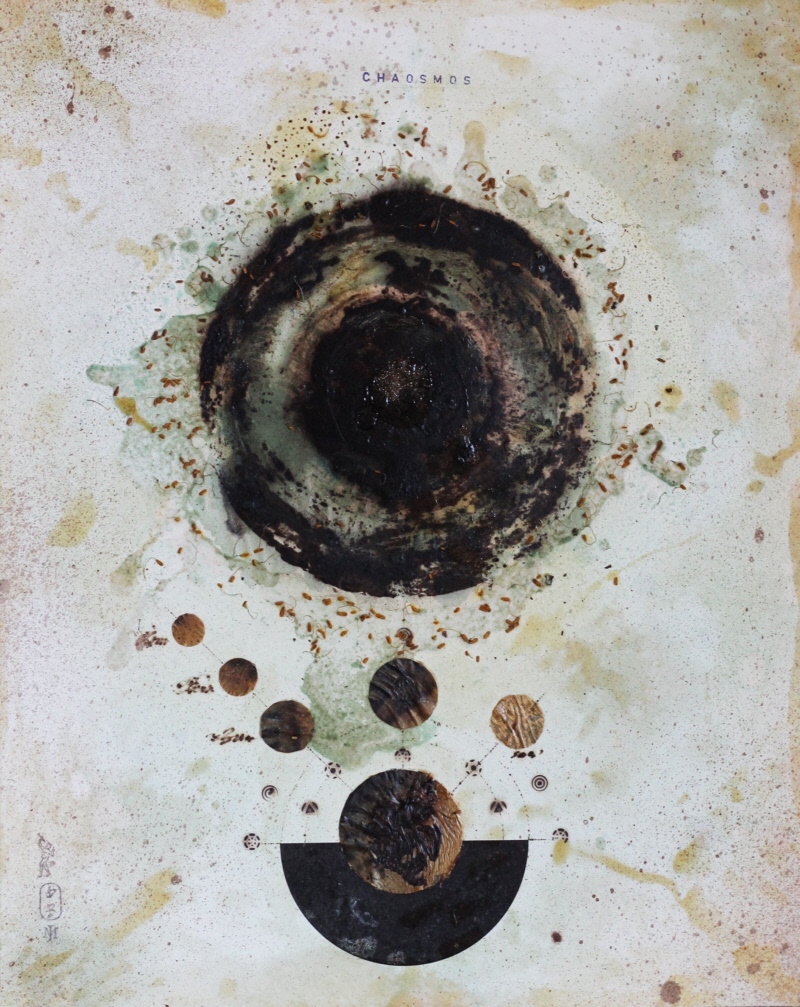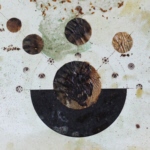
Régis Pirastru
Chaosmos
Technique mixtes: encres, laque, brou de noix, pigments, oxydation, vernis, pollen, peau de maquereaux
……..
Uriel Frisch and Cornelius Rampf
Astrophysique
CNRS
Chez les astronomes et les physiciens des particules il y a un large consensus que l’Univers, tel que nous le connaissons, a débuté il y a environ 14 milliards d’années. Ce démarrage, connu comme le Big Bang, fut une gigantesque explosion chaotique de matière à haute densité et à haute température, dépourvu de centre.
Maintenant, l’Univers est encore chaotique, mais en même temps, il montre un grand degré d’organisation, révélant des planètes (y compris la Terre), des étoiles (y compris le Soleil), des galaxies (y compris la Voie Lactée), des amas de galaxies, etc. sur des distances de milliards d’années lumière.
Comment donc avons-nous pu quitter le Big Bang pour obtenir un Univers organisé? Cela s’est produit très rapidement, en moins de 400.000 ans, donc en moins d’un 35.000ème de l’âge de l’Univers. Au cours de l’explosion primitive de l’Univers, ce dernier s’est aussi considérablement refroidi, grâce à l’expansion de l’espace. De ce fait, les particules chargées négativement (appelées électrons) et les particules chargées positivement s’accouplèrent en des minimariages (appelés parfois des atomes). C’était le début de l’état normal de la matière (électriquement neutre), du type qu’on trouve chez nous sur Terre.
Ainsi, la majeure partie du chaos initial disparut et l’Univers s‘organisa en structures étonnamment complexes. D’un point de vue mathématique, l’Univers chaotique devint soudainement très lisse. Une seconde naissance de l’Univers se fit jour. Ce phénomène peut être comparé à ce que vécut Léonard de Vinci, vers l’an 1480, quand les gens n’avaient que leurs yeux pour explorer les parties les plus proches de l’Univers. À Florence, observant l’écoulement de l’eau contre les ponts de l’Arno, Léonard utilisa des lunettes de sa facture pour observer les mouvements chaotiques s’organisant progressivement en turbulences de longue durée, terme qu’il proposa pour la première fois.

There is currently a broad consensus among astrophysicists and particle physicists, that the Universe, as we know it, started about 14 billion years ago. It started with a “Big Bang”, a tremendous and chaotic explosion with a very high density and temperature of matter, without any preferred center.
Now, the Universe is still chaotic, but at the same time it displays a high degree of organization, revealing planets (including the Earth), stars (including the Sun), galaxies (including our Milky Way), clusters of galaxies, and so on, over distances of billions of light years.
How did we leave the initial chaotic Big Bang to become an ordered Universe? It happened very quickly over less than 400,000 years, that is less then the current age of the Universe divided by 35,000. In the early explosion the Universe did not only explode but also cooled down very much, thanks to the expansion of space. As a consequence, negatively charged particles (called electrons) and positively charged particles started engaging in microscopic “marriages” (some of them called atoms). This was the beginning of “normal” (electrically neutral) matter of the kind that surrounds us here on Earth.
This quickly removed most of the initial chaos and lead to a Universe displaying amazingly organized patterns. From a mathematical perspective, the chaotic Universe, all of a sudden, became very smooth. A true second birth of the Universe saw the day. The phenomenon can actually be compared to what Leonardo da Vinci experienced around the year 1480, when people had only their naked eyes to explore the nearest parts of the Universe. In Florence, in the flow of water against bridges in the Arno river, Leonardo used his self-made eye goggles to observe a chaotic flow slowly changing into long-lived “turbulence”, as he called it for the first time.